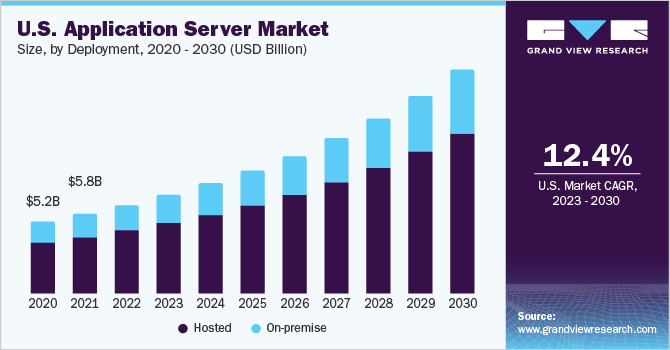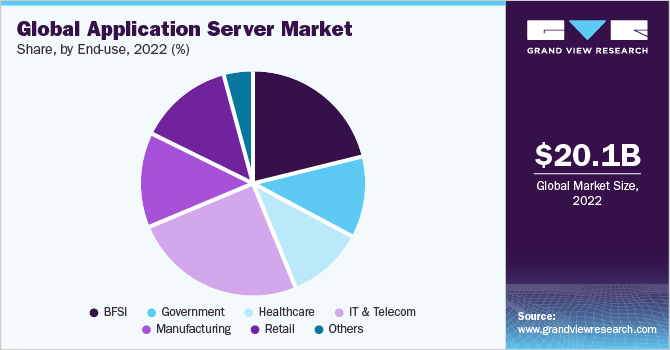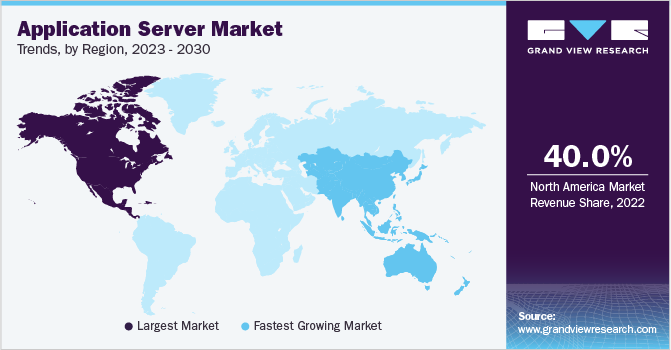- Home
- »
- IT Services & Applications
- »
-
Application Server Market Size, Share, Growth Report, 2030GVR Report cover
![Application Server Market Size, Share & Trends Report]()
Application Server Market Size, Share & Trends Analysis Report By Type (Java, Microsoft Windows), By Deployment (Hosted, On-premise), By End-use (BFSI, Manufacturing, IT & Telecom), And Segment Forecasts, 2023 - 2030
- Report ID: GVR-3-68038-241-9
- Number of Report Pages: 111
- Format: PDF, Horizon Databook
- Historical Range: 2018 - 2021
- Forecast Period: 2023 - 2030
- Industry: Technology
Application Server Market Size & Trends
The global application server market size was estimated to be USD 20.06 billion in 2022 and is expected to grow at a compound annual growth rate (CAGR) of 13.9% from 2023 to 2030. The growth of the application server market can be attributed to various factors, such as the growing popularity of mobile apps and increasing e-commerce sales, among others. The use of application servers has been increasing, which can be attributed to the rise in demand for mobile apps for functionalities such as gaming, and mobile payments, among others. Application servers help in secure communication and facilitate push payments. The presence of key companies in the market that offers payment application servers has also facilitated the rising adoption of application servers for payment services.

For instance, Stanchion Payment Solutions offers payment application servers that reduce operational risk, offer easy deployment, faster time to market, and compatibility with any payment switch technology stack. Using application servers for communication is another factor contributing to its adoption in all devices. Multiple companies in the application market offer enhanced communication application servers. For instance, Intelligent Business Communication - AGNITY offers Communication Application Server (CAS), a virtualized service delivery platform designed for service providers to meet high capacity and throughput needs. The platform's architecture is layered and modular, facilitating smooth expansion when new network connectivity is required for additional applications.
An application server is a foundation for all other applications the e-commerce companies would be running on their websites. Most e-commerce architectures depend on a web server or a packet sniffer as a source for clickstream data. Both these systems have the advantage of being non-intrusive, letting them bolt onto any e-commerce application. But their limitations become evident in high-level logging events. They cannot particularly exploit metadata available in the application. Hence, the demand for application servers capable of keeping track of information not present in web server logs, including aborted pages, is remarkably increasing.
There are top companies in the market that offer application servers for e-commerce requirements, which has also facilitated the rise in the adoption of application servers among e-commerce businesses. For instance, IBM offers IBM WebSphere Commerce, an on-premises e-commerce platform, which enables B2B and B2C businesses to drive and innovate their omnichannel businesses quickly. The rise in e-commerce sales is another factor that has contributed to the growth of the market. For instance, according to E-commerce News Europe, e-commerce revenue in Europe had increased by 13% in 2021 compared to 2020, reaching a value of USD 813 (EUR 718) billion. This trend is expected to continue, resulting in more people who opt for online shopping. The increasing e-commerce sales, along with the presence of tailor-made application servers for e-commerce, have been a significant contributor to the growth of the market.
Application servers allow software developers to build and host new web applications supported by the server environment. Application servers also provide the services necessary to improve web applications' diagnostic capabilities and security. As a result, web developers can track, identify, and troubleshoot issues with their web applications efficiently. Application servers provide access to business records remotely in real time and help streamline business processes. Moreover, the application server provides flexibility and ease of use to avoid the expenses and complexities of developing e-commerce applications. Intensifying competition in the e-commerce industry and the growing need for applications that can support sales by accessing records remotely are expected to drive the market's growth.
Type Insights
The Java-type segment of the market is estimated to occupy more than 50% of the market size in 2022. Java application server is an open-source platform that offers software applications, data services, security, load balancing, transaction support, and management of large allocated systems. The server plays the role of a virtual machine that runs applications and, at the same time, handles connections to the database and web clients. Types of Java application servers include JBoss, Tomcat, and Jetty, among others. The growth of this segment can be attributed to the increasing implementation and adoption of these servers by enterprises, mainly in the e-commerce and retail sectors. Further, many companies in the market offer Java application servers, including IBM Corporation and The Apache Software Foundation. The enhanced performance of Java application servers, including scalability, security, and portability, has also contributed to its wider adoption, fueling market growth.
By Java Type, the J Boss subsegment is projected to witness the highest growth rate over the forecast period. JBoss application server is an open-source platform created to allow developers to focus on the business architecture of the server, thus reducing the time and effort spent on challenging tasks such as programming and coding to connect different working parts. It is less complex and can be easily deployed on the cloud as it provides on-demand service provisioning and elasticity. JBoss is used in enterprise applications and includes a middleware platform to speed up application development, deployment, execution, data integration, and automation.
JBoss is a cross-platform application server that supports Java and can function on any operating system. It also comprises security services such as Pluggable Authentication Modules (PAM) and Java Authentication and Authorization Service (JAAS). The advantages JBoss offers to different businesses are expected to contribute to the segment's growth over the forecast period.
Deployment Insights
By deployment, the hosted segment will occupy more than 70% in 2022. The hosted application server segment is anticipated to grow significantly due to the advancements in information-sharing technologies and the increasing use of mobile devices. Larger enterprises are shifting their focus towards hosted application servers because they can handle workloads from multiple sites, typically from the same database. Hosted applications are among the pioneer service models of cloud services. The hosted application server deployment is more accessible than traditional application servers as it requires fewer system integrations and no upfront installations, reducing operating and maintenance costs. The hosted application server is wholly managed by the hosting service provider, which regularly updates the version and offers continuous technical & customer support.
The on-premise segment of the market by deployment is projected to have significant growth over 2023-2030. Various end-user organizations prefer on-premise application server deployments due to easy implementation customization. Further, on-premise deployments are equipped with advanced security features which assist organizations in complying with various government regulations. It gives organizations more control over sensitive data and assists with compliance. However, there is an increasing preference for cloud deployment due to scalability, flexibility, and software updates, among others.
End-use Insights
The IT & telecom segment of the market by end-use segment is estimated to occupy the largest share of the market, occupying more than 25% in 2022. The IT & telecom industry has seen a transformation, where the telecom industry has witnessed the implementation of fixed to mobile broadband services. The IT industry has seen a growing implementation of cloud-based services after on-premise service offerings. Earlier, subscribers had multiple service providers; however, most services are available through a single service provider. The multimedia capabilities of mobile phones are expected to evolve further. For this purpose, the conventional network infrastructure issues are giving way to new issues of after-sales service delivery and execution. The network operators are gradually transforming into software companies and predominantly information technology companies. These factors are contributing to the market growth.

The manufacturing segment of the market by end-use is expected to register the highest growth rate over the period 2023-2030. Increasing customer requirements for the availability and on-time delivery of the product are driving the demand for improved efficiency in the manufacturing sector. The rapidly increasing deployment of sensors-connected devices and the Internet of Things (IoT) are expected to play a considerable role in accelerating the manufacturing sector’s requirement for application servers. Personal and business communication applications, real-time data analytics, and work collaboration applications are some of the significant applications expected to drive the growth of the manufacturing segment over the forecast period.
Regional Insights
North America will occupy more than 40% of the market by region in 2022. The growth of this region can be attributed to the presence of some of the top players in the market, who are based in North America. Some significant companies based in North America include IBM, Microsoft, and Oracle. Moreover, the region is home to the world's largest economy, the U.S., which demands high usage of application servers for various activities such as IT, manufacturing, and healthcare. Thus, the abovementioned factors are expected to drive the market's growth over the forecast period. Asia Pacific region is projected to witness the highest growth rate of more than 16% from 2023-2030.

Asia Pacific is home to some of the largest economies in the world, such as China, India, Japan, and South Korea, and some of these counties is a manufacturing hub. The region is also home to some significant companies in the market, including Fujitsu and NEC Corporation. The continued digitalization in developing economies and the large number of internet users in countries such as China and India have also played a role in developing the market in the region.
Key Companies & Market Share Insights
The key players operating in the market include Microsoft Corporation, International Business Machines Corporation, Oracle Corporation, Red Hat, Inc., TIBCO Software, Inc., FUJITSU, and VMware, Inc. To broaden their product offering, industry companies utilize a variety of inorganic growth tactics, such as partnerships, regular mergers, and acquisitions. For instance, in December 2022, Microsoft collaborated with the London Stock Exchange Group (LSEG) to upgrade LSEG's data infrastructure using Microsoft Cloud. It jointly developed products for data and analytics and assisted both companies' clients in automating time-consuming & complex processes and enhancing application deployments. Some of the prominent players dominating the global application server market include:
-
Adobe
-
FUJITSU
-
F5, Inc.
-
Hewlett Packard Enterprise Development LP
-
International Business Machines Corporation
-
Microsoft Corporation
-
Nastel Technologies.
-
NEC Corporation
-
Oracle Corporation
-
Payara Services Ltd
-
Red Hat, Inc.
-
SAP SE
-
TIBCO Software, Inc.
-
The Apache Software Foundation
-
VMware, Inc.
Application Server Market Report Scope
Report Attribute
Details
Market size value in 2023
USD 22.66 billion
Revenue forecast in 2030
USD 56.34 billion
Growth rate
CAGR of 13.9% from 2023 to 2030
Base year for estimation
2022
Historical data
2018 - 2021
Forecast period
2023 - 2030
Report updated
May 2023
Quantitative units
Revenue in USD billion and CAGR from 2023 to 2030
Report coverage
Revenue forecast, company market share, competitive landscape, growth factors, and trends
Segments covered
Type, deployment, end-use, region
Regional scope
North America; Europe; Asia Pacific; Latin America; Middle East & Africa
Country scope
U.S.; Canada; Germany; U.K.; France; Italy; Spain; China; India; Japan; South Korea; Australia; Brazil; Mexico; Argentina; U.A.E.; Saudi Arabia; South Africa
Key companies profiled
Adobe; FUJITSU; F5, Inc.; Hewlett Packard Enterprise Development LP; International Business Machines Corporation; Microsoft Corporation; Nastel Technologies.; NEC Corporation; Oracle Corporation; Payara Services Ltd; Red Hat, Inc.; SAP SE; TIBCO Software, Inc.; The Apache Software Foundation; VMware, Inc.
Customization scope
Free report customization (equivalent up to 8 analysts working days) with purchase. Addition or alteration to country, regional & segment scope.
Pricing and purchase options
Avail customized purchase options to meet your exact research needs. Explore purchase options
Global Application Server Market Report Segmentation
This report forecasts revenue growth at regional and country levels and provides an analysis on the latest industry trends in each of the sub-segments from 2018 to 2030. For this study, Grand View Research has segmented the global application server market report based on type, deployment, end-use, and region:
-
Type Outlook (Revenue, USD Billion, 2018 - 2030)
-
Java
-
J Boss
-
Jetty
-
Tomcat
-
Others
-
-
Microsoft Windows
-
Others
-
-
Deployment Outlook (Revenue, USD Billion, 2018 - 2030)
-
Hosted
-
On-premise
-
-
End-use Outlook (Revenue, USD Billion, 2018 - 2030)
-
BFSI
-
Government
-
Healthcare
-
IT & Telecom
-
Manufacturing
-
Retail
-
Others
-
-
Regional Outlook (Revenue, USD Billion, 2018 - 2030)
-
North America
-
U.S.
-
Canada
-
-
Europe
-
Germany
-
U.K.
-
France
-
Italy
-
Spain
-
-
Asia Pacific
-
China
-
India
-
Japan
-
South Korea
-
Australia
-
-
Latin America
-
Brazil
-
Mexico
-
Argentina
-
-
Middle East & Africa
-
U.A.E.
-
Saudi Arabia
-
South Africa
-
-
Frequently Asked Questions About This Report
b. The global application server market size was estimated at USD 20.06 billion in 2022 and is expected to reach USD 22.66 billion in 2023.
b. The global application server market is expected to grow at a compound annual growth rate of 13.9% from 2023 to 2030 to reach USD 56.34 billion by 2030.
b. The Java segment accounted for the largest market share of more than 50% in 2022 in line with the continued adoption of application servers by the incumbents of the e-commerce industry.
b. The hosted segment accounted for the largest application server market share of around 70% in 2022 and is expected to register the highest CAGR of 14.2% over the forecast period.
b. The BFSI segment accounted for a market share of around 20% of the global application server market in 2020.
b. North America dominated the market for application servers in 2022 and accounted for a revenue share of over 40%.
b. Some key players operating in the application server market include IBM Corporation; Microsoft; Oracle; Red Hat, Inc.; TIBCO Software Inc.; The Apache Software Foundation; Fujitsu; NEC Corporation; VMware Inc.; SAP SE; and NGINX Inc.
b. Key factors that are driving the application server market growth include the increasing use of computer & mobile applications and the High growth potential of e-commerce and m-commerce.
Share this report with your colleague or friend.
![gvr icn]()
NEED A CUSTOM REPORT?
We can customize every report - free of charge - including purchasing stand-alone sections or country-level reports, as well as offer affordable discounts for start-ups & universities. Contact us now
![Certified Icon]()
We are GDPR and CCPA compliant! Your transaction & personal information is safe and secure. For more details, please read our privacy policy.
We are committed towards customer satisfaction, and quality service.
"The quality of research they have done for us has been excellent."





